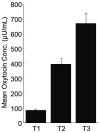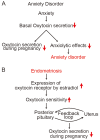Plasma Oxytocin Concentrations During and After Gestation in Japanese Pregnant Women Affected by Anxiety Disorder and Endometriosis
- PMID: 33253338
- PMCID: PMC7683907
- DOI: 10.33160/yam.2020.11.012
Plasma Oxytocin Concentrations During and After Gestation in Japanese Pregnant Women Affected by Anxiety Disorder and Endometriosis
Abstract
Background: Oxytocin has a key role in mother-infant bonding, maternal care, social interaction, and stress-related psychiatric disorders. However, the factors determining oxytocin concentrations during and after pregnancy such as medical history related to nursing or parental behavior are unknown. To elucidate these, we analyzed the relationships between oxytocin concentrations during and after pregnancy, and medical history assessed in the Japan Environment and Children's Study (JECS).
Methods: We then selected the pregnant women with a medical history of anxiety disorder and endometriosis as cases and pregnant women without medical history as controls adjusting the cohort for age and parity for a nested case-control study, after which 162 women remained for analysis. We evaluated 162 pregnant women from JECS using answers provided in a questionnaire and by measuring plasma oxytocin concentration by ELISA during the first (T1) and second (T2) trimesters of pregnancy, and after childbirth (T3).
Results: Oxytocin concentration increased in a time dependent manner, consistent with previous reports. There were weak negative correlations between oxytocin concentration at T1 and the mother's age and height, but no correlation with other factors. The mean oxytocin concentrations of pregnant women with a history of an anxiety disorder (n = 7) and endometriosis (n = 13) were significantly lower than those of pregnant women with no such history at T2 and T3.
Conclusion: These results suggest that oxytocin concentrations during and after pregnancy were affected by a past history of anxiety disorder and endometriosis. This is the first study of the relationship between oxytocin concentration and endometriosis. To elucidate the molecular mechanisms, further study is needed.
Keywords: anxiety disorder; endometriosis; oxytocin.
©2020 Tottori University Medical Press.
Conflict of interest statement
The authors declare no conflict of interest.
Figures



Similar articles
-
Changes in salivary oxytocin levels and bonding disorder in women from late pregnancy to early postpartum: A pilot study.PLoS One. 2019 Sep 3;14(9):e0221821. doi: 10.1371/journal.pone.0221821. eCollection 2019. PLoS One. 2019. PMID: 31479475 Free PMC article.
-
The role of serum oxytocin levels in the second trimester in regulating prenatal anxiety and depression: A sample from Shanghai Maternal-Child Pairs Cohort study.J Affect Disord. 2020 Mar 1;264:150-156. doi: 10.1016/j.jad.2019.12.019. Epub 2019 Dec 14. J Affect Disord. 2020. PMID: 32056744
-
Obstetrical Complications in Women with Endometriosis: A Cohort Study in Japan.PLoS One. 2016 Dec 22;11(12):e0168476. doi: 10.1371/journal.pone.0168476. eCollection 2016. PLoS One. 2016. PMID: 28005934 Free PMC article.
-
The Role of Oxytocin and the Effect of Stress During Childbirth: Neurobiological Basics and Implications for Mother and Child.Front Endocrinol (Lausanne). 2021 Oct 27;12:742236. doi: 10.3389/fendo.2021.742236. eCollection 2021. Front Endocrinol (Lausanne). 2021. PMID: 34777247 Free PMC article. Review.
-
Revisiting the wandering womb: Oxytocin in endometriosis and bipolar disorder.Horm Behav. 2017 Nov;96:69-83. doi: 10.1016/j.yhbeh.2017.09.005. Epub 2017 Sep 19. Horm Behav. 2017. PMID: 28919554 Review.
Cited by
-
Modulation of Melatonin Receptors Regulates Reproductive Physiology: The Impact of Agomelatine on the Estrus Cycle, Gestation, Offspring, and Uterine Contractions in Rats.Physiol Res. 2023 Dec 31;72(6):793-807. doi: 10.33549/physiolres.935064. Physiol Res. 2023. PMID: 38215065 Free PMC article.
References
-
- American Psychiatric Association. Diagnostic and Statistical Manual of Mental Disorders, 5th ed. Arlington, VA: American Psychiatric Publishing; 2013.

